2013 Peugeot 508 roof
[x] Cancel search: roofPage 4 of 340
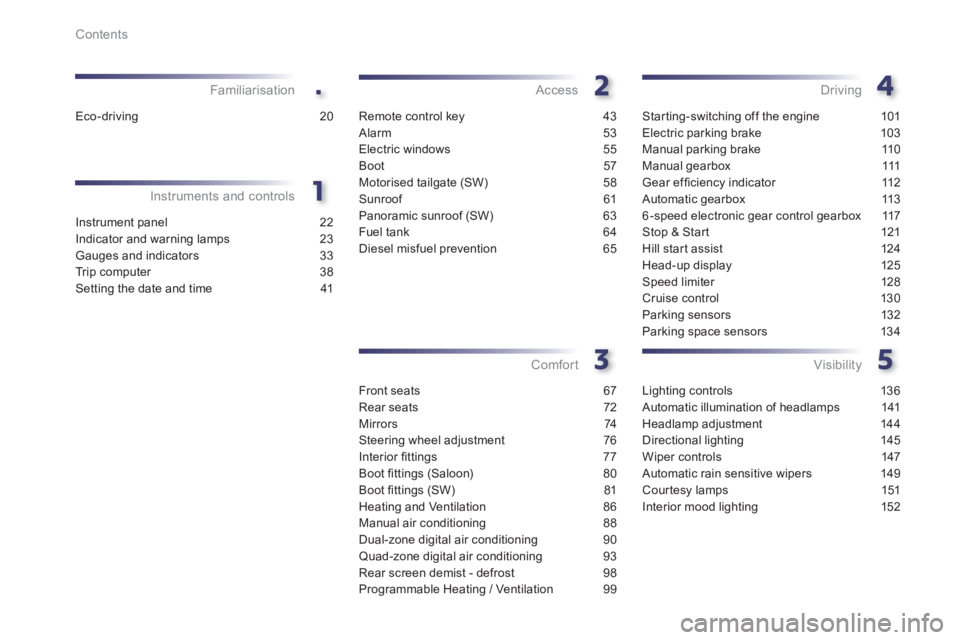
.
Contents
Instrument panel 22
Indicator and warning lamps 23
Gauges and indicators 33
Tr ip computer 38
Setting the date and time 41
Instruments and controlsFamiliarisation
Remote control key 43
Alarm 53
Electric windows 55
Boot 57
Motorised tailgate (SW) 58
Sunroof 61
Panoramic sunroof (SW) 63
Fuel tank 64
Diesel misfuel prevention 65
Access
Front seats 67
Rear seats 72
Mirrors 74
Steering wheel adjustment 76
Interior fi ttings 77
Boot fi ttings (Saloon) 80
Boot fi ttings (SW) 81
Heating and Ventilation 86
Manual air conditioning 88
Dual-zone digital air conditioning 90
Quad-zone digital air conditioning 93
Rear screen demist - defrost 98
Programmable Heating / Ventilation 99
Comfort
Starting-switching off the engine 101
Electric parking brake 103
Manual parking brake 110
Manual gearbox 111
Gear effi ciency indicator 112
Automatic gearbox 113
6-speed electronic gear control gearbox 117
Stop & Star t 121
Hill start assist 124
Head-up display 125
Speed limiter 128
Cruise control 130
Parking sensors 132
Parking space sensors 134
Driving
Lighting controls 136
Automatic illumination of headlamps 141
Headlamp adjustment 144
Directional lighting 145
Wiper controls 147
Automatic rain sensitive wipers 149
Cour tesy lamps 151
Interior mood lighting 152
Visibility
Eco-driving 20
Page 5 of 340
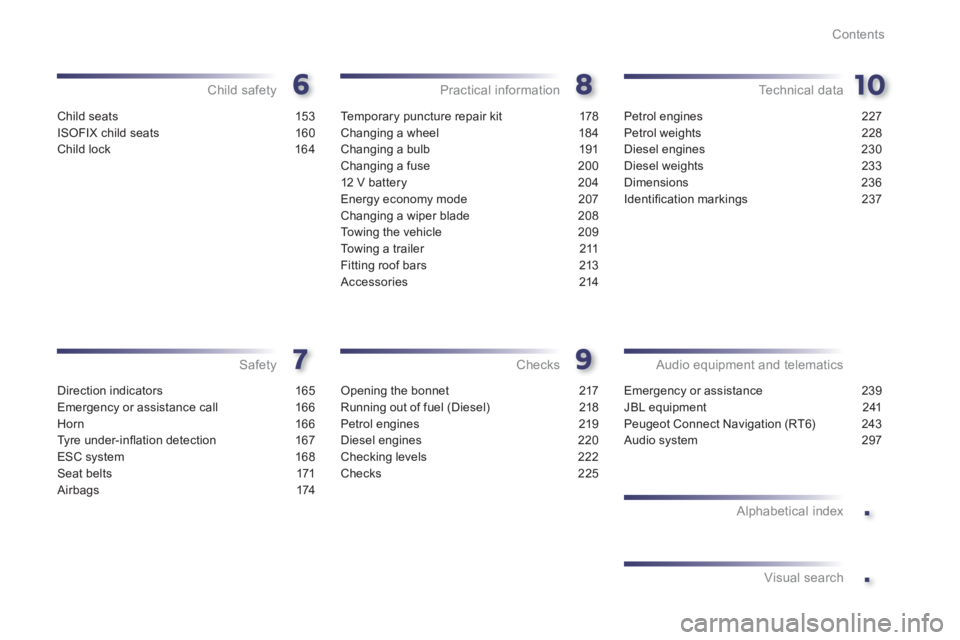
.
.
Contents
Child seats 153
ISOFIX child seats 160
Child lock 164
Child safety
Direction indicators 165
Emergency or assistance call 166
Horn 166
Tyre under-infl ation detection 167
ESC system 168
Seat belts 171
Airbags 174
Safety
Te m p o r a ry puncture repair kit 178
Changing a wheel 184
Changing a bulb 191
Changing a fuse 200
12 V battery 204
Energy economy mode 207
Changing a wiper blade 208
To w i ng the vehicle 209
To w i ng a trailer 211
Fitting roof bars 213
Accessories 214
Practical information
Opening the bonnet 217
Running out of fuel (Diesel) 218
Petrol engines 219
Diesel engines 220
Checking levels 222
Checks 225
Checks
Petrol engines 227
Petrol weights 228
Diesel engines 230
Diesel weights 233
Dimensions 236
Identifi cation markings 237
Technical data
Emergency or assistance 239
JBL equipment 241
Peugeot Connect Navigation (RT6) 243
Audio system 297
Audio equipment and telematics
Alphabetical index
Visual search
Page 22 of 340
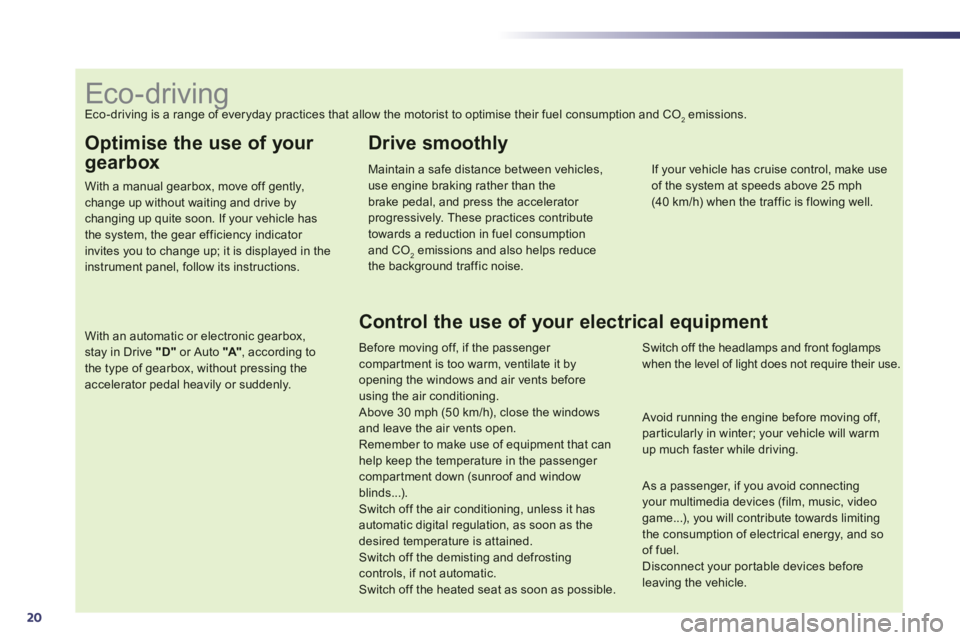
20
Optimise the use of your
gearbox
With a manual gearbox, move off gently,change up without waiting and drive by changing up quite soon. If your vehicle has the system, the gear efficiency indicator invites you to change up; it is displayed in the instrument panel, follow its instructions.
With an automatic or electronic gearbox, stay in Drive "D"or Auto "A"
, according to the type of gearbox, without pressing theaccelerator pedal heavily or suddenly.
Drive smoothly
Maintain a safe distance between vehicles,use engine braking rather than thebrake pedal, and press the accelerator progressively. These practices contributetowards a reduction in fuel consumptionand CO2emissions and also helps reduce the background traffic noise.
If your vehicle has cruise control, make useof the system at speeds above 25 mph (40 km/h) when the traffic is flowing well.
Control the use of your electrical equipment
Before moving off, if the passenger compartment is too warm, ventilate it byopening the windows and air vents beforeusing the air conditioning.
Above 30 mph (50 km/h), close the windows and leave the air vents open.
Remember to make use of equipment that canhelp keep the temperature in the passenger compartment down (sunroof and windowblinds...).
Switch off the air conditioning, unless it has automatic digital regulation, as soon as thedesired temperature is attained. Switch off the demisting and defrostingcontrols, if not automatic. Switch off the heated seat as soon as possible.
Switch off the headlamps and front foglamps when the level of light does not require their use.
Avoid running the engine before moving off,
particularly in winter; your vehicle will warmup much faster while driving.
As a passenger, if you avoid connecting your multimedia devices (film, music, videogame...), you will contribute towards limitingthe consumption of electrical energy, and soof fuel.
Disconnect your por table devices beforeleaving the vehicle.
Eco-driving Eco-driving is a range of everyday practices that allow the motorist to optimise their fuel consumption and CO2emissions.
Page 23 of 340
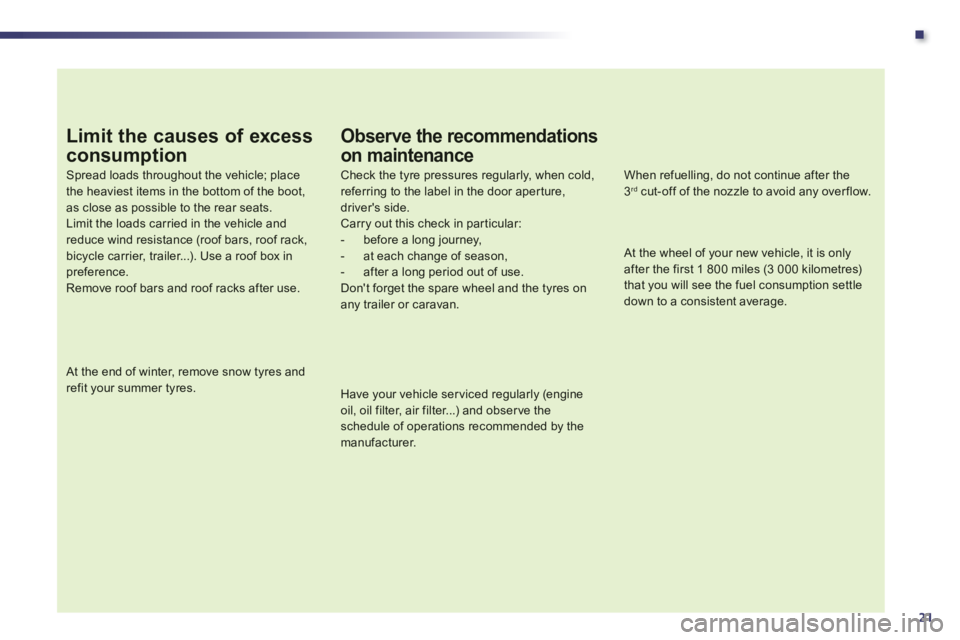
.
21
Limit the causes of excess
consumption
Spread loads throughout the vehicle; placethe heaviest items in the bottom of the boot,as close as possible to the rear seats.Limit the loads carried in the vehicle and reduce wind resistance (roof bars, roof rack, bicycle carrier, trailer...). Use a roof box inpreference.Remove roof bars and roof racks after use.
At the end of winter, remove snow tyres and refit your summer tyres.
Observe the recommendations
on maintenance
Check the tyre pressures regularly, when cold, referring to the label in the door aper ture, driver's side.Carry out this check in par ticular:- before a long journey,- at each change of season,- after a long period out of use. Don't forget the spare wheel and the tyres onany trailer or caravan.
Have your vehicle ser viced regularly (engine oil, oil filter, air filter...) and obser ve the schedule of operations recommended by the
manufacturer.
When refuelling, do not continue after the3 rd
cut-off of the nozzle to avoid any over flow.
At the wheel of your new vehicle, it is only after the first 1 800 miles (3 000 kilometres) that you will see the fuel consumption settledown to a consistent average.
Page 49 of 340
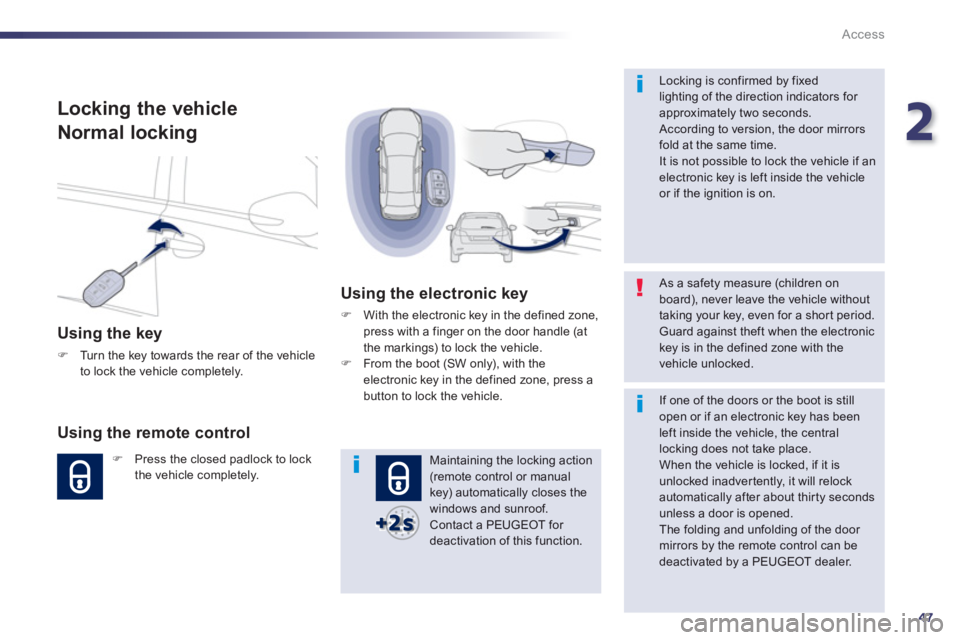
2
47
Access
Locking the vehicle
Normal lockin
g
Using the key
F
Turn the key towards the rear of the vehicle
to lock the vehicle completely.
Using the remote control
FPress the closed padlock to lockthe vehicle completely.
Using the electronic key
FWith the electronic key in the defined zone,
press with a finger on the door handle (at
the markings) to lock the vehicle. FFrom the boot (SW only), with theelectronic key in the defined zone, press a button to lock the vehicle.
Maintaining the locking action (remote control or manual key) automatically closes the windows and sunroof.
Contact a PEUGEOT for deactivation of this function.
As a safety measure (children on board), never leave the vehicle withouttaking your key, even for a shor t period. Guard against theft when the electronickey is in the defined zone with the vehicle unlocked.
Locking is confirmed by fixedlighting of the direction indicators for approximately two seconds.
According to version, the door mirrorsfold at the same time.
It is not possible to lock the vehicle if an electronic key is left inside the vehicleor if the ignition is on.
If one of the doors or the boot is still open or if an electronic key has been left inside the vehicle, the centrallocking does not take place.
When the vehicle is locked, if it isunlocked inadvertently, it will relockautomatically after about thir ty secondsunless a door is opened.
The folding and unfolding of the door mirrors by the remote control can bedeactivated by a PEUGEOT dealer.
Page 63 of 340
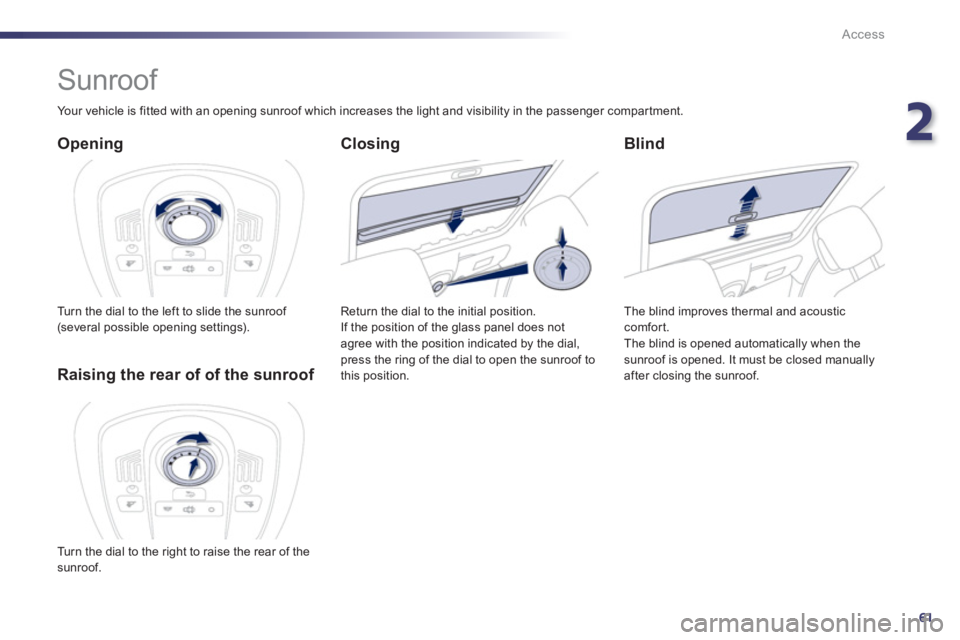
2
61
Access
Sunroof
Opening
Turn the dial to the left to slide the sunroof (several possible opening settings).
Blind
The blind improves thermal and acoustic comfort.
The blind is opened automatically when the sunroof is opened. It must be closed manually
after closing the sunroof.
Raising the rear of of the sunroof
Your vehicle is fitted with an opening sunroof which increases the light and visibility in the passenger compartment.
Return the dial to the initial position.
If the position of the
glass panel does notagree with the position indicated by the dial, press the ring of the dial to open the sunroof to
this position.
Closing
Turn the dial to the right to raise the rear of the sunroof.
Page 64 of 340
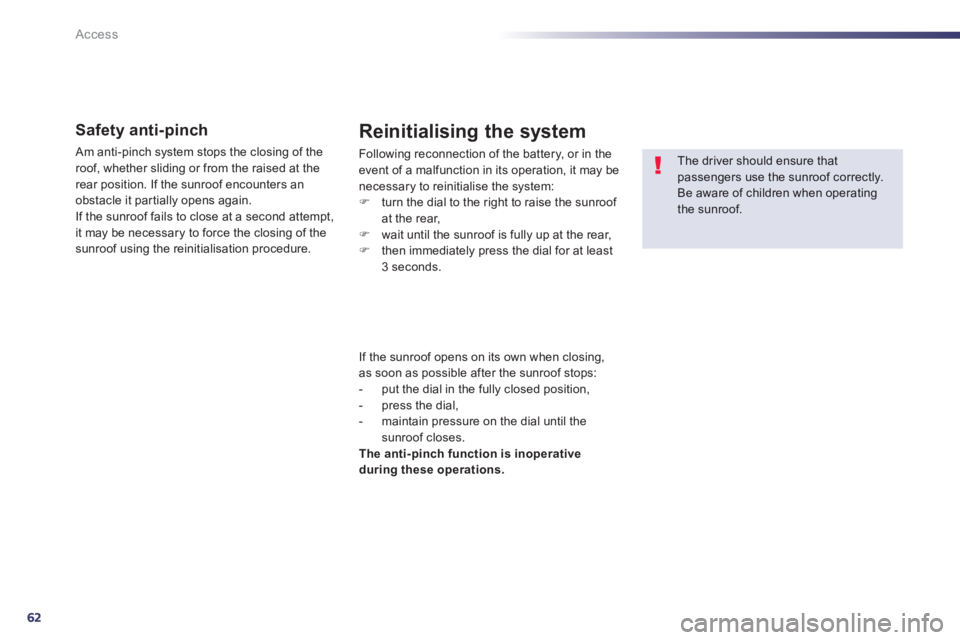
62
Access
Safety anti-pinch
Am anti-pinch system stops the closing of the roof, whether sliding or from the raised at the rear position. If the sunroof encounters an
obstacle it par tially opens again.
If the sunroof fails to close at a second attempt,
it may be necessary to force the closing of thesunroof using the reinitialisation procedure.
Reinitialising the system
Following reconnection of the battery, or in the
event of a malfunction in its operation, it may be
necessary to reinitialise the system: F turn the dial to the right to raise the sunroof
at the rear,
F wait until the sunroof is fully up at the rear,F
then immediately press the dial for at least3 seconds.
I
f the sunroof opens on its own when closing,
as soon as possible after the sunroof stops:
- put the dial in the full
y closed position,
- press the dial,
- maintain pressure on the dial until the
sunroof closes.The anti-pinch function is inoperative during these operations.
The driver should ensure that passengers use the sunroof correctly. Be aware of children when operatingthe sunroof.
Page 65 of 340
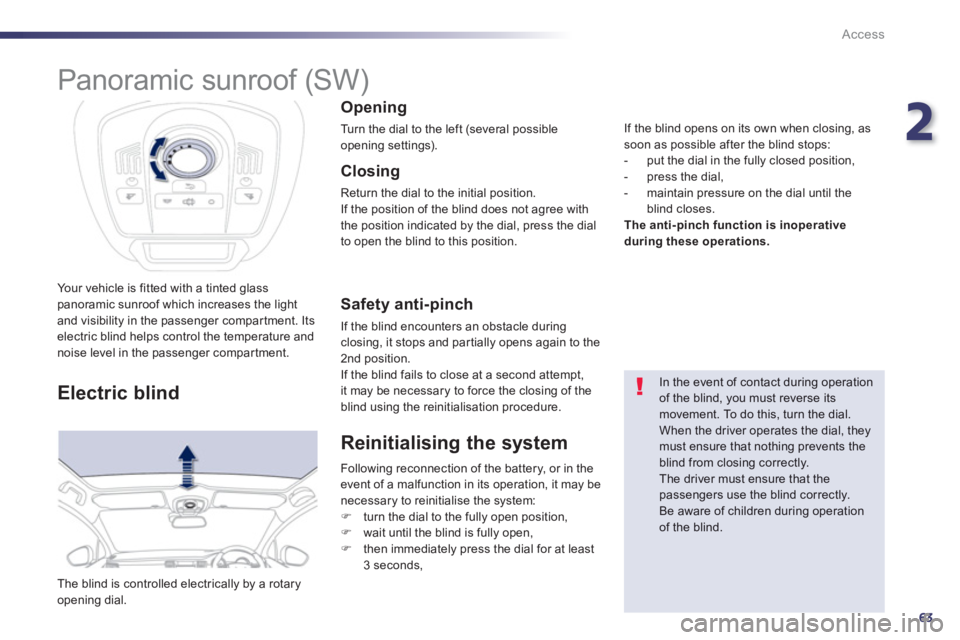
2
63
Access
Your vehicle is fitted with a tinted glass panoramic sunroof which increases the light
and visibility in the passenger compartment. Itselectric blind helps control the temperature andnoise level in the passenger compartment.
The blind is controlled electrically by a rotaryopening dial.
Opening
Turn the dial to the left (several possible
opening settings).
Safety anti-pinch
If the blind encounters an obstacle during closing, it stops and par tially opens again to the 2nd position.
If the blind fails to close at a second attempt,
it may be necessary to force the closing of the blind using the reinitialisation procedure.
Closing
Return the dial to the initial position.
If the position of the blind does not agree with
the position indicated by the dial, press the dial
to open the blind to this position.
Electric blind
In the event of contact during operationof the blind, you must reverse its movement. To do this, turn the dial. When the driver operates the dial, theymust ensure that nothing prevents theblind from closing correctly.
The driver must ensure that the passengers use the blind correctly.
Be aware of children during operationof the blind.
Reinitialising the system
Following reconnection of the battery, or in the
event of a malfunction in its operation, it may be necessary to reinitialise the system: Fturn the dial to the fully open position,
Fwait until the blind is fully open,
Fthen immediatel
y press the dial for at least3 seconds,
I
f the blind opens on its own when closing, assoon as possible after the blind stops:
- put the dial in the full
y closed position,
- press the dial,
- maintain pressure on the dial until the
blind closes.
The anti-pinch function is inoperative during these operations.
Panoramic sunroof (SW)